China enters Aircraft Carrier Manufacturing Arena
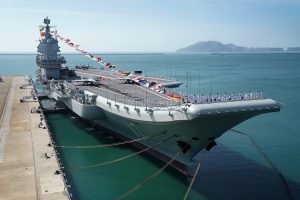 Courtesy Daily Sabah
Courtesy Daily Sabah
China possesses an extended air defence coverage and its threat perception lies in the likely commissioning in the year 2023 of a Type 002 carrier outfitted with catapult launch enabling a multi role capability. This effort lends credence to the theory that China is in pursuit of blue water outreach. Presently the US Navy maintains its numerical superiority over the Chinese Navy with a fleet of 11 nuclear powered super carriers . Chinese ambitions remain confined to Pacific waters and are not exacting on its revenue streams on account of which it has the fiscal space available to consistently and rigorously pursue its maritime ambitions.
Global Maritime Hegemony
The cornerstone of China’s strategic planning is based on the notion that it does not need to command global maritime hegemony in the manner the US does fuelling China’s ambitions to endeavour to protect strategic and relatively less costlier sea routes embracing a predominant segment of global trade exceeding $ 5 trillion annually. China’s future strategy may include maintaining security of choke points in the Indian Ocean’s seaborne trade in vital energy supplies and straddling sea lanes through which almost 80 % of world energy cargoes pass.
Multiple Players in Pacific Waters
In western eyes China and the renegade North Korea are seen as military collaborators. With the blessings of the western powers South Korea’s military brass plans to take its defence preparedness a notch higher by enlarging the role of the Directorate of Countering Nuclear and Weapons of Mass Destruction (WMD) and establishment of a unified strategic command by the year 2024. South Korea operates a Cyber Operations Command and under its external security canvas missiles, submarines, fighter aircrafts including F-35 and the space and electromagnetic grid function.
A 3 tiered system known as Korea Massive Punishment and Retaliation (KMPR) , or referred to as Kill Chain Strike Platform , is poised to come into operation in case any conflict escalates to nuclear level .The KMPR is essentially an operational plan designed to launch preemptive strikes to decimate the North Korean military command if and when the intensity of the military engagement so necessitates .
Sensationalism
Apart from combat operations its present aircraft carriers , bolstered by an air wing of 40 fixed and rotary-wing aircraft supported by maritime patrol , China’s naval presence contributes to sensationalisation in the Western media at times to an absurd extent. At a later stage the Chinese fleet would be complemented by four nuclear-powered super carriers which would be at par in capability to the US Nimitiz reaching an air wing upto 100 fixed and rotary-wing aircraft. Such acquired capability would have an impact with the potential to alter the strategic scheme of naval dynamics.
Cruise
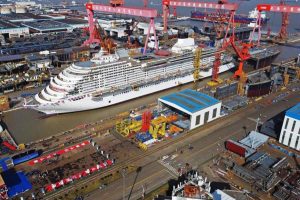 Courtesy Bangkok Post
Courtesy Bangkok Post
China is nearing completion of its pioneer cruise ship.Although the cruise ship of 135,000 GRT may seem a small achievement and paling in comparison to an aircraft carrier yet it is more complex then constructing a bulker. The cruise ship has a range of intricate systems and is an advanced form of shipbuilding product .
China Breaches Maritime Frontiers
A Chinese container vessel has sailed through the Arctic slashing cargo delivery time to Europe by almost 50 % . The vessel named ” The Istanbul Bridge ” is of 2000 vintage and is Ice Class Ice-1 with a container capacity of 4,843 TEU. Last year the same ship had transited the Artic route under the name ” Flying Fish 1″. The actual distance traveled as per digital tracking was 7,850 nautical miles at an average speed of 15 knots.
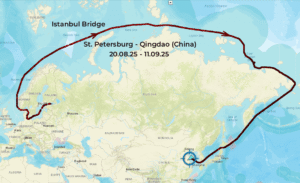 Credit;CHNL
Credit;CHNL
The journey took 20 days till the ship docked at Felixstowe, Britain’s largest container port with the port of origin being Ningbo-Zhoushan Port in East China. The vessel carried around 4,000 containers containing lithium-ion batteries and solar panels onwards bound from Britain to ports in Germany, Poland and the Netherlands.
Artic Route – The New Maritime Frontier
By sailing along the the Arctic route at times called the Northeast Passage (NSR) the vessel bypassed the longer Suez Canal and Cape of Good Hope routes, which entails a journey upto 50 days and a distance of 11,000 miles. The NSR route outpaces the China-Europe Railway Express which takes around 25 days . Excluding port calls the independent time estimate is 27 days as vessels typically travel non-stop along the NSR, whereas port calls are frequent along the Suez Canal route thereby increasing overall transit time.
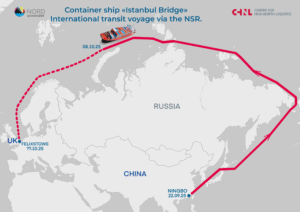 Credit;Center for High North Logistics
Credit;Center for High North Logistics
Icy Conditions
The ice charts of the East Siberian Sea depict that during this particular voyage there was open water and a sufficiently wide clear passage between Wrangel Island and the Pevek port area. The open water navigation season on the NSR has a relatively small window and is not predictable in terms of timing. Two months back this region had ice accumulation and transiting vessels experienced difficulties. The Istanbul Bridge was fortunate and passed the eastern NSR segment at high speed through open water.
Ice Breaker Support
During the vessel’s passage through the East Siberian Sea the nuclear icebreaker 50 Let Pobedy was present however the vessel sailed independently. A second nuclear icebreaker, Sibir, operating in the area, was anchored near the shore north of Pevek port. The shipping company which operates the ship, had prepared for 3 years for the voyage, upgrading vessel hardware, training crews and improving meteorological navigation forecasts.
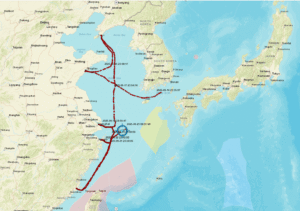 Credit;CHNL
Credit;CHNL
In the near future the NSR could streamline supply chains and improve logistics efficiency as shorter transit times can lower inventory costs up to 40 % making markets responsive to rapidly changing market demands.
Climate Change Benefits China
The NSR , running entirely through Arctic waters and within Russia’s exclusive economic zone , can now be navigated by vessels on account of global warming. The shorter maritime journey significantly reduces carbon emissions and benefits time-sensitive and heat-sensitive cargo. Low Arctic temperatures enable high-tech components to be preserved in frigid environment while calmer seas reduce vessel movement and the risk of damage to precision parts. The Arctic has warmed about 4 times faster than the global average over the last 4 decades opening seasonal opportunities for shipping, though weather and sea conditions remain unpredictable. China has bolstered maritime cooperation with Russia by adopting alternatives to the Strait of Malacca in Southeast Asia. China’s exports to Europe rose by 14% in September 2025 and to the U.S. dropped by 27 % demonstrating China’s resolve to diversify trade .The shipping company nurtures ambitious plans to expand its services along the NSR by inducting ice-class ships by 2026 , revising its summer shipping schedule and significantly developing express services to Eastern Europe during non-navigable winter months.
By Nadir Mumtaz
Trademark Blue Economy (IPO)

Sources , Credit :
https://chnl.no/news/container-ship-istanbul-bridge-on-international-transit-voyage-via-the-nsr/

Leave A Comment